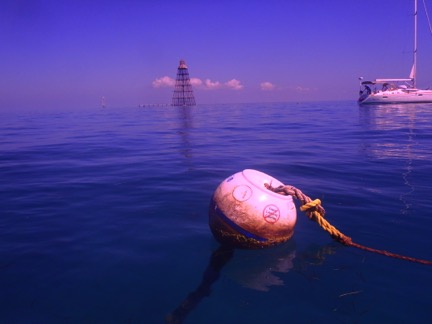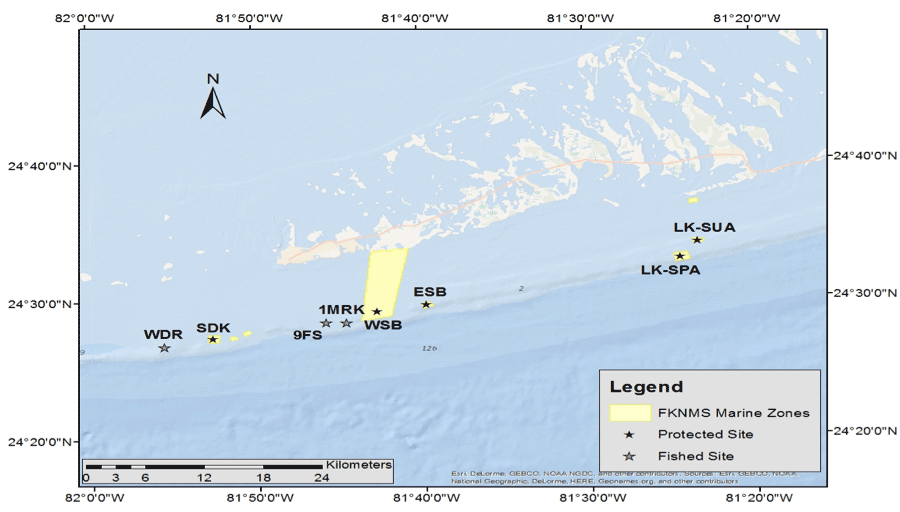Integration of Soundscapes and Coral Reef Surveys to Evaluate the Efficacy of FKNMS Management Zones
Project Overview

Coral reef management objectives have shifted beyond achieving sustainability for individual target species to broader impacts of fishing on
community interactions and food web dynamics. Studying the soundscapes of coral reef communities is an emerging, non-invasive approach to understand the relationship between reef fish diversity and benthic habitat complexity. Additionally, tracking species-specific sounds can answer key questions about periodicity and duration of activities such as spawning, or changes in local fish abundance.
In this collaborative study with the Florida Fish & Wildlife Conservation Commission (FWCC), we use a multidisciplinary approach using passive underwater acoustics, habitat data, and ecological surveys to (1) quantify density, size, and habitat associations of reef fish, threatened coral, and macroalgal species among various management zones (fished, no-take but with public access, no-take and no public access) in the Florida Keys National Marine Sanctuary, (2) directly observe grazing activity of parrotfish and other herbivorous fish using UW video surveys coupled with hydrophone recordings to explore acoustic signatures of species-specific grazing behavior, and (3) characterize spatiotemporal periodicity in reef fish spawning behavior for both target and non-target reef fish species via hydrophone recordings.
Research Questions
- Does the soundscape of a coral reef reflect reef fish biodiversity and habitat complexity?
- How does the level of protection across fished and non-fished sites (i.e. SPAs, SUAs, ERs) affect eco-acoustic metrics (e. Acoustic Entropy, H or Acoustic Complexity Index, ACI)?
- Can the species-specific sounds of herbivorous fish grazing (specifically parrotfish) become a potential non-invasive monitoring tool for herbivorous fish densities?
Study Systems
Due to increasing stress on regional fisheries and coral reefs, the Florida Keys National Marine Sanctuary (FKNMS) in 1997 established a network of 18 “no-take” Sanctuary Preservation Protected (SPAs) and one “no-take” Ecological Reserve (ER). In addition, a total of four Special-Use Areas/Research-Only (SUAs) were established that are both no-take and no entry. The sites selected for protection vary greatly in size and reef type, and include 10 well-developed fore-reef areas, 7 inshore patch reefs, 6 offshore patchreef/hardbottom areas, and one large ER that contains offshore reefs, inshore reefs, seagrass, and hardbottom areas. With the exception of the ER, most SPAs and SUAs are relatively small (~ 0.2 to 0.5 km2).

Methods
- Quantify reef fish species composition, density, size, and habitat associations among the various management zones (SPAs, ERs, SUAs, fished) in the lower FKNMS (i.e., Zone D of the FKNMS) using a two-stage, point count survey method by divers (Smith et al. 2011)
- Quantify biotic and abiotic characteristics of reefs using maps and in situ measures of rugosity and % habitat cover, as well as video-transect methods
- Characterize the soundscape at each reef site using underwater hydrophones
- Directly observe feeding activity of parrotfish and other herbivorous fish using diver roving video surveys coupled with hydrophone recordings.
The proposed study will be conducted during a 12 month period across seasons (winter, spring, summer, fall) in 2017-19 to observe potential seasonal variation across reef fish and eco-acoustic metrics.
